This asana is a torso and spinal twist in a forward fold. It is a deeper version of revolved triangle pose. This pose is a popular pose in many yoga competitions and has a few variations which are demonstrated in the article later. This pose requires good forward fold balance, shoulder flexibility, hamstring flexibility and good range of movement and strength across the torso and muscles supporting the spine.
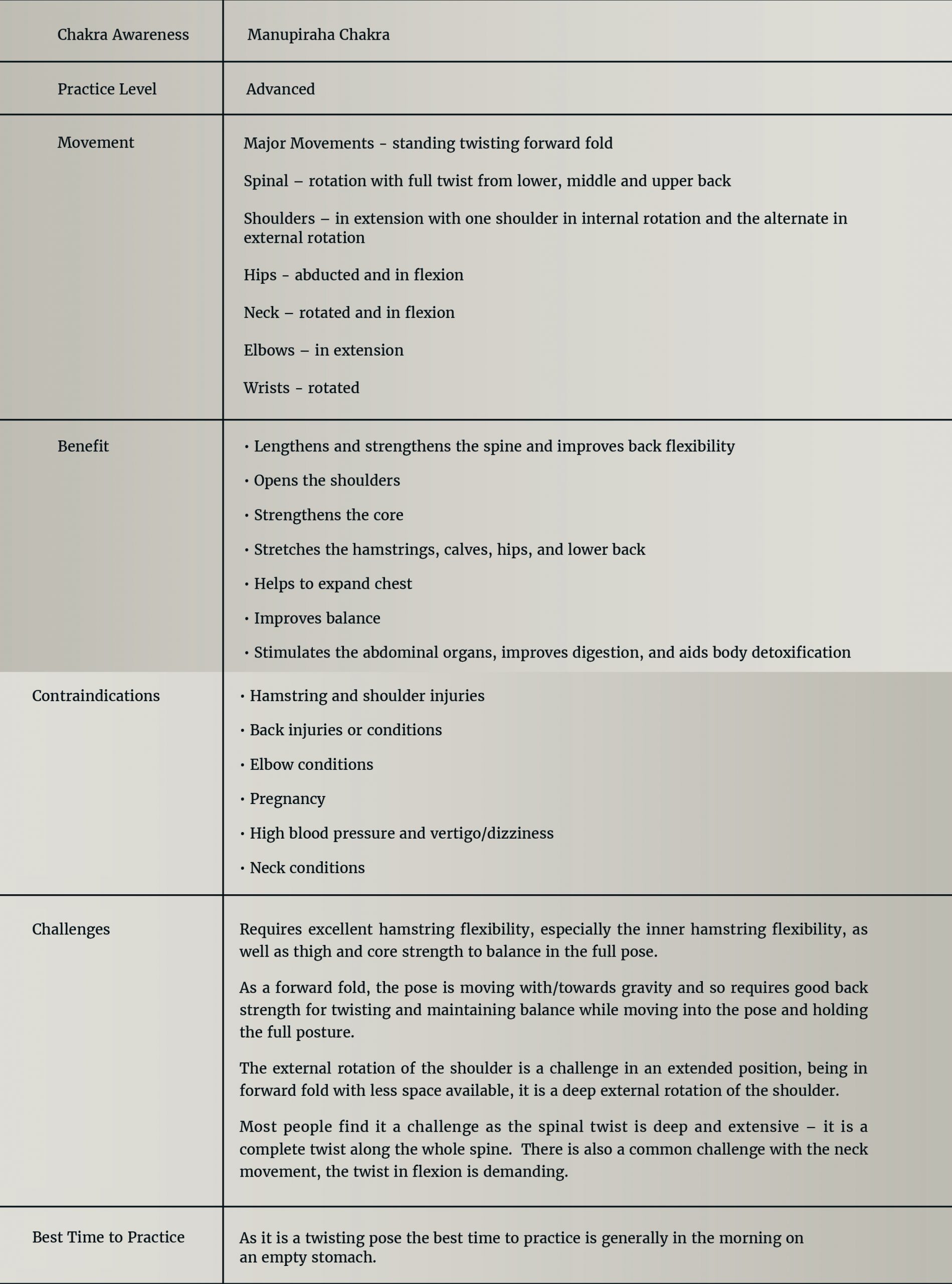
Warm-up
The warm up focuses on standing forward fold, hamstring stretch, shoulder opening, twisting and opening the chest and inner thighs.
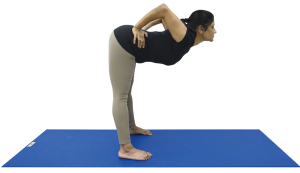
1. Stand straight with feet wider than hip-width apart;
2. Inhale, bend elbows and hold the waist;
3. Exhale and move into a half forward fold – roll shoulders back and spread shoulder blades, squeeze elbows towards each other to engage the back muscles, and extend chest and chin forward while keeping the neck relaxed;
4. Feel the stretch on hamstrings and hips.
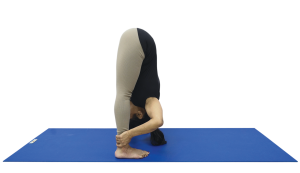
Prasarita Padottanasana
1. Stand straight, inhale and take arms above the head and lengthen the whole spine;
2. As you exhale, go into a full forward fold, hold the ankles, keep elbows wide, and pull shin bones to widen shoulder blades and keep inner shoulders away from the neck – this helps keep the upper and middle back muscles engaged;
3. Chest and head go down and in, draw the abdomen long and in to raise the hips high and pull the spine down;
4. Keep the lower abdomen touching the thighs.
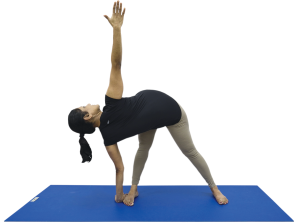
Revolved triangle pose variation
1. Stand straight with legs elbow width apart;
2. Inhale with arms up and lengthen, as you exhale first bend into half forward fold with hands parallel to ground;
3. Twist to the right and place the left hand outside the right foot with fingers pointing backwards. Turn the torso completely to the right first and then look backwards on the right side;
4. Lengthen both sides of the body and raise the right arm up, both shoulders should stack one above the other;
5. Draw the left side of the abdomen to touch the right inner thigh;
6. Try to keep the left hip back and in line with the right hip, drawing the abdominals long and in will help this;
7. Repeat for the left side.
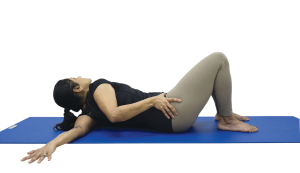
Shoulder warm-up
1. Lie down on the abdomen. Take the left hand out with the left palm a little above the left shoulder;
2. Slowly move onto the left side of the body, bend the knees and stacked them on top of each other;
3. Take the right knee up and hold the right hip with the right hand. Move the hip forward and right to find space for the lower back to touch the ground;
4. See how much you can lie on the lower back, if possible raise both knees to face upwards;
5. Feel a deep stretch to chest muscles and the left shoulder through external rotation;
6. Repeat for the right side.
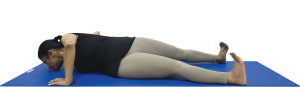
Twisting warm up
1. Sit with legs apart and extended;
2. Twist to the right, place the hands down and behind like a wide push up;
3. Keep the palms mat width apart and behind and away from the hips;
4. Keep elbows perpendicular to the wrists and slowly twist, trying to extend the left chest more while bringing the chin or forehead down to the mat;
5. Repeat for the left side.
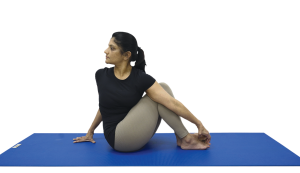
Seated twist
1. Sit with legs apart and bend the knees, keep the knees close to each other and try not to lean back;
2. Raise the left arm up, inhale to lengthen the whole left side, as you exhale twist to the right and lock the left elbow outside right knee;
3. Keep the right hand back behind the tailbone and bend the right elbow to open the right chest and turn more to the right;
4. With every inhale raise the chest up and widen the shoulder blades, as you exhale twist more and squeeze the abdomen fully to face right or even behind;
5. Continuously press the left elbow into the right knee and twist more to hold the bottom of the toes with the left hand;
6. Twist right with whole back as you walk your right hand to the other end of the mat and finally turn the neck to the right and back;
7. Repeat on the left side.
Eligibility poses
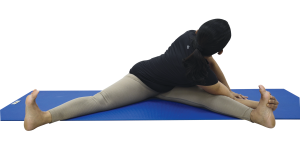
1. Twisted variation of Upavistha Konasana
1. Sit with legs 90 degrees apart or around that depending on flexibility. Tilt hips forward and press the finger
-tips down to lift the lower back up and lengthen through the abdomen and waistline – ensure you are on your sit bones and not rounding down in the lower back onto the tail bone;
2. First twist to the left and hold left ankle with both hands, keep the back straight and if possible bring the forehead to touch the shin bone;
3. Later hold the outside of the left foot with the right hand and the left hand outside left leg pressing down. Twist further to face the whole body to the left side, right elbow and left palm pressing down outside the left leg to assist deepen the twist;
4. Repeat on the right side.
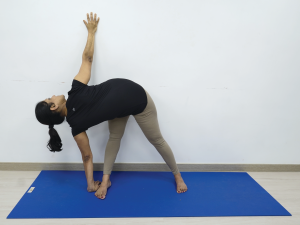
2. Revolved triangle pose close to wall
1. Take some distance from wall and stand with feet elbow width apart;
2. Inhale and as you exhale go into a half forward fold and then twist to the right, place the left hand outside the right foot with the fingers pointing to the wall and left abdomen touching the right inner thigh as close as possible;
3. Inhale and lengthen your chest, widen the shoulder blades, and as you exhale lengthen the whole torso long while parallel to the ground;
4. Raise the right arm and shoulder above the left arm at 90 degrees and touch the wall with the right palm. Lengthen the back of the neck and turn to look at the right palm touching the wall;
5. This is a balance pose, so ground the left leg well with the outer heel and ball of the foot, lengthen the abdomen at both sides as you exhale to fully stabilise through the legs and thighs fully engaged;
6. Repeat on the left side.
This pose gives the full warm up for the final pose.
Steps
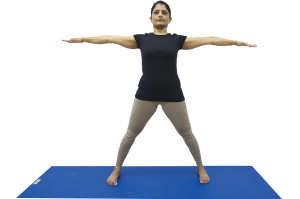
1. Steps to the final pose
• Stand with feet elbow width apart and toes pointing in;
• Spread your arms palms facing down and hands parallel to the ground;
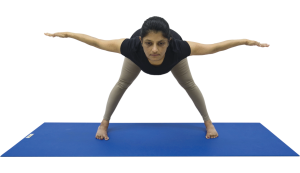
2. Forward fold
• Inhale and as you exhale do a half forward fold with arms parallel to the ground;
• Keep thighs strong extend your chest and chin forward shoulders back and back straight;
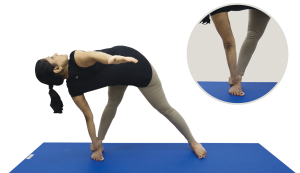
3. Revolved Triangle pose variation
• Inhale lengthen and exhale twist to your right, the left hand holds the left ankle from outside with the whole body facing to the right;
• Turn the torso to the right side and keep the left side of the abdomen close to the right inner thigh;
• Keeping the thighs strong and feet grounded, lengthen the lower abdomen as you exhale;
• Open the chest to the ceiling and take the right hand out to the front, turn the whole body to face the ceiling;
• Hold lengthen the neck and look to the ceiling, lift up and away from the left hand and right ankle;

• Again inhale and with exhale, move slowly with balance towards the centre slightly, turning with whole lower middle and upper back and neck;
• Externally rotate the right shoulder to hold left inner thigh;
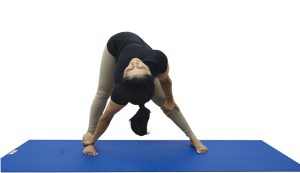
• Slowly glide your right palm down along the inner left thigh;
• Every time as you inhale and exhale, twist the whole back, expand the chest, and keep the shoulder blades wide to avoid pinching of nerves in the shoulder joint;
• Moving slowly with awareness throughout the body and with your breathe helps to remain stable and strong with balance in the posture;
• Keep the neck stable and engaged as you rotate and feel the whole torso opening to ceiling.
Final Pose
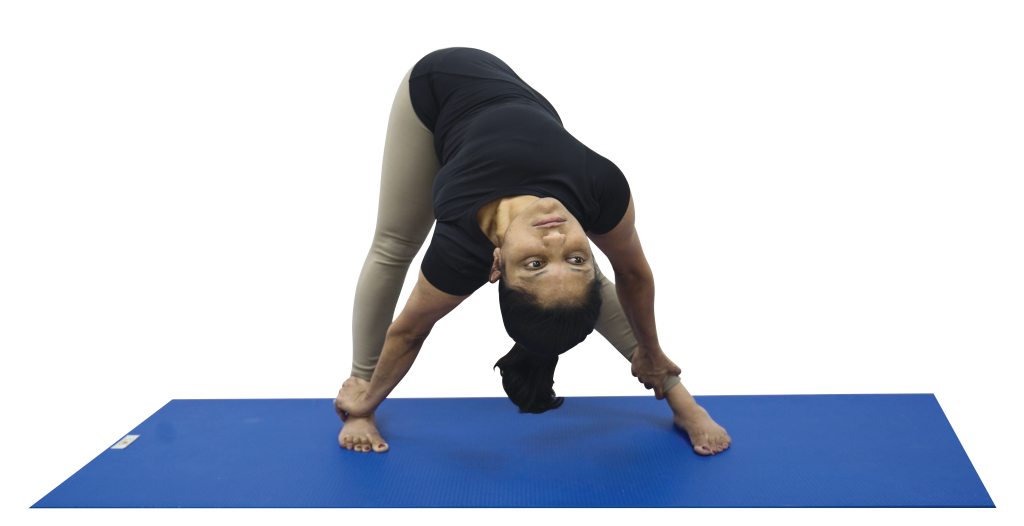
• In the final pose we walk the right hand fully down to hold the inside of the left ankle;
• Keep small breaths through chest as it is a full twist and is hard to take deep breaths in this position;
• Through every inhale, expand and lengthen the chest, and turn with the whole back;
• Keeping the thighs strong and engaged, and ensure the feet are grounded well to help keep balance;
• Lightly push with the left hand and lightly pull with right hand;
• Keep the lower abdomen long and in to hold the hips high and inner thighs long;
• Don’t let weight fall away towards the front of the feet to avoid falling and avoid hyper-extending the elbows as they will have to oppose that force to maintain the pose;
• Continuously lifting the whole body up with engagement in the left side muscles and stretching the opposite side muscles is required;
• Hamstring flexibility, adductor muscles flexibility, with full back opening, strong abdominal muscles, strong upper back and open shoulders and neck flexibility are necessary requirements for this pose;
• Repeat for the opposite side of the body.
Variations
Variation pose can help, your body get necessary strength and flexibility to reach the final pose or it can be also be similar pose with some variation.

• Inhale and as you exhale go into Prasarita Padottan
asana – wide leg forward fold;
• Hold opposite ankles and keep balance;
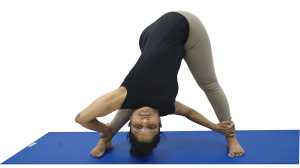
• Holding opposite ankles and as you exhale, keep balance and twist in between the legs;
• Open the elbows wide to keep the body as centred as possible and again maintain balance with thighs strong and feet grounded.
Modifications
Since this pose requires good shoulder opening, back opening, upper and middle back strength, hamstring flexibility and balance, there are certain modifications for students of different levels when working towards the final pose.
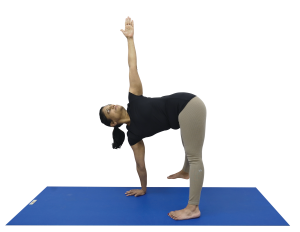
1. For shoulder and back limitation
• Stand straight with feet elbow width apart and one foot next to wall;
• Inhale and exhale to half forward fold with arms wide and parallel to the ground;
• Inhale and as you exhale keep your right palm down and twist with left hand up while lengthening the torso and twisting with the whole back. Try to expand your chest and shoulder blades wide;
• Roll shoulders down, both arms aligned one above the other; Look up, or in front if neck feels strained;
• Try to work with the whole spine and keep the feet grounded equally front and back;
• Don’t make the bottom arm heavy, roll that shoulder down and push the shoulder to the left;
• Repeat on the opposite side.

2. Second variation for people with less upper back strength
• After first step – inhale and as you exhale move the right shoulder forward to the left by twisting uniformly through the spine to the top of the neck;
• Open the chest to face ceiling and reach with your left hand to the wall; From here you can work on walking the left hand down with wall support;
• Repeat opposite side.
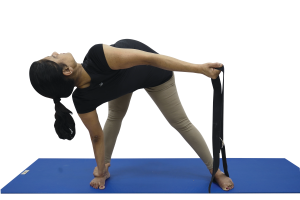
3. Belt option
• Make a loop to the belt, keep the loop elbow length – not very small to start with;
• Keep the loop around the right foot; With legs wide, sit in a squat, hold the left ankle with the right hand and externally rotate the left shoulder to hold the loop from the inside;
• Inhale and as you exhale twist with the whole back and stand, keeping balance and opening the chest, arms and shoulders to enter the pose;
• Keeping the loop bigger helps to ease tension on the shoulders, back and inner hamstrings initially, shortening the loop as the range of mobility increases;
• Repeat on the opposite side.
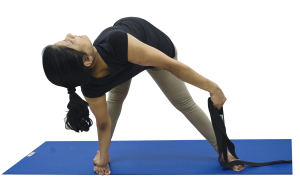
4. For people who need help for shoulder and back flexibility
• After the third modification, you can work slowly to bring the body to centre and twist more with every breath;
• Bring the right hand closer to ankle by walking the hand down the loop while all the time keeping focus on balance;
• Repeat on the opposite side.
Neutralising Pose
Neutralising poses help us to relieve stress or tension collected in all the muscles or joints which we use during the asana. This brings the key areas to a neutral position after the asana and aids in preventing any injuries. It is important to do these poses after asana.
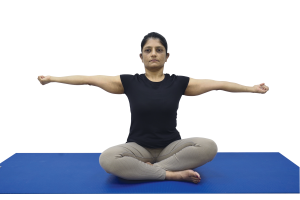
• Just stretch your arms out with palms up make a fist and widen the shoulder blades, keep the spine neutral.
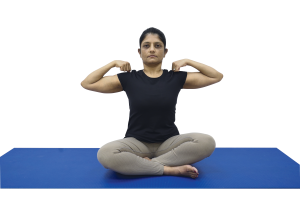
• After the first step bend the elbows to touch the fist to collar bones – to neutralise the elbow joints.
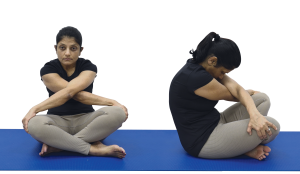
• Sit in cross leg position and hold opposite knees from outside;
• Hunch the whole back, roll on the tail bone to fully round the lower, middle and upper back and tuck the chin in;
• Feel a nice stretch to the back and back of neck and a release of the shoulder joints and muscles.
Counter pose
Counter poses are counter stretching and engaging poses to the muscles used in an asana. This helps to prevent any overstretch or over engagement in muscles used during the asana.
In this pose the back muscles get lengthened and stretched across the spine, they release fully. So a strength pose for the back muscles is a good counter pose. Also, the hamstrings get a good stretch during the asana, so. hamstring strengthening pose is also a good counter pose .
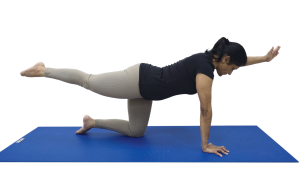
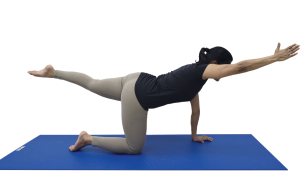
• Come to all fours table top pose;
• Inhale and as you exhale and extend the opposite leg and hand in opposite direction to reach out;
• Engage the whole back body, the back and spinal muscles, glutes, hamstrings, and calf muscles are all active and engaged, as well as the upper back and entire arm;
• Keep extended arm and leg towards centre line;
• Repeat both sides.
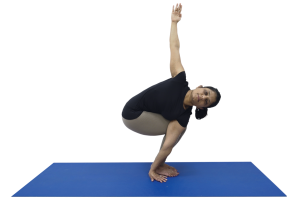
Adductor muscles strengthening
• Since this pose involves inner thigh stretching, the above pose is a good counter to strengthen;
• Inhale and as you exhale, come to a chair pose with knees together;
• Take the left arm up and as you exhale lock left elbow outside the right knee;
• Twist the torso, squeeze the abdomen out to the right side as you exhale;
• Try to bring the left ribs outside the right thigh and then place the left palm down next to the right foot;
• Extend the right arm above the left arm and widen the shoulder blades – look to the side or up while holding the posture.
Gomukhasana
This pose is stretches the IT bands and strengthens the inner thighs which were doing opposite actions in the asana – so this is a good counter pose. The shoulders are moving in opposite directions, with the top shoulder externally rotating and the bottom shoulder internally rotating. This pose can be repeated by changing legs and hands to give counter movements to Parivrtta Prasarita Padottanasana.
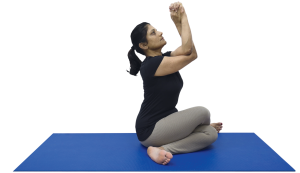
• Sit with your right knee on top of your left knee, keep the feet apart outside the thighs as wide as possible and sit with the hips between the two feet and try to keep both hips down equally;
• As you exhale, feel the engagement in your inner thighs. Take the left elbow on top of the right and do an eagle bind of the arms – make the palms into a fist if possible;
• Inhale, spread the shoulder blades and as you exhale try to lift the elbows above shoulder level but don’t raise the collar bones;
• Try to press the top knee on the bottom knee with hips grounded;
• Repeat again two times and change legs and hands.
Contraindications
• The pose should be avoided by those who have or have suffered shoulder, leg (especially hamstrings and inner thigh) back and neck injuries;
• The pose is an inversion – hips are above the head, therefore the pose should be avoided by those suffering from high blood pressure, vertigo and similar issues.
As you look at this pose it seems to be intimidating and impossible for beginners, but every asana should not be looked at from the shape it is creating in our body. It should be measured by the space it is creating in our body and mind, giving it strength and stillness. As you go into the final pose it seems as if divinity and awareness is reaching out from deep within throughout our body. Finally, our body, mind, asana and everything around, is changing, except for the divinity and awareness within us which is changeless, timeless and limitless. So though the shape looks intimidating, the limitless divinity within us has given us unlimited capacity to find the pose.
By Shilpa Patil (instagram @shilpisp)
under the guidance of Dr. Yogananth Andiappan














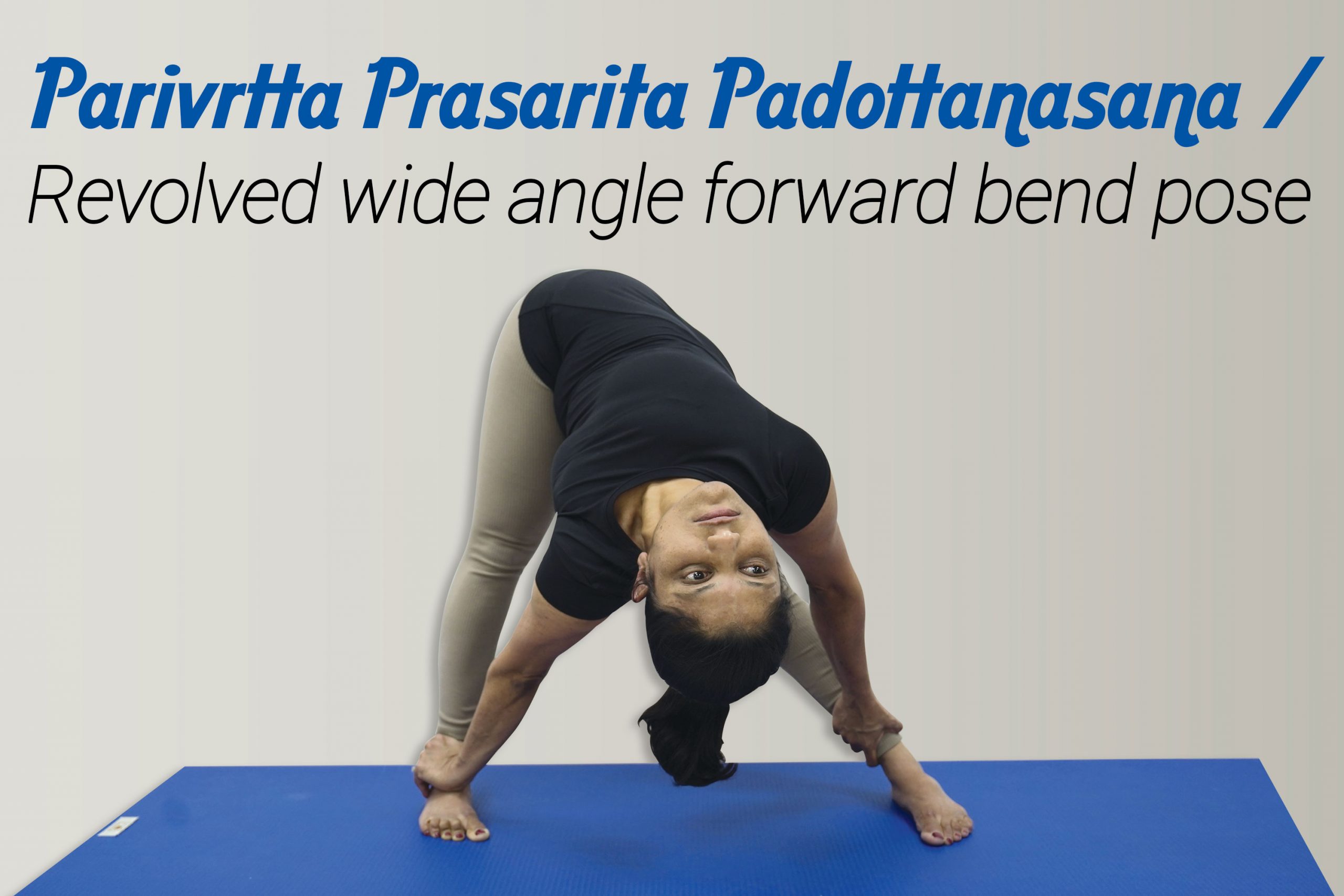



 Other
Other